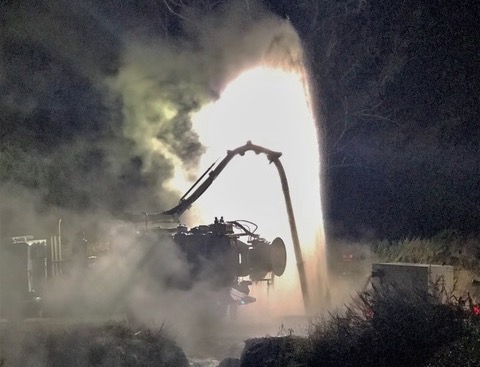
Laguna Beach has agreed to pay more than $1.5 million to settle with state water regulators for its role in a November 2019 sewage spill that temporarily closed 16 miles of Orange County’s coastline.
A settlement agreement with the San Diego Regional Water Quality Control Board resolves an Administrative Civil Liability for the discharge of 1.7 million gallons into the Pacific Ocean.
“The San Diego Water Board Prosecution Team has been working closely with the City of Laguna Beach to reach this settlement and provide it for public comment,” Chiara Clemente, enforcement coordinator for the San Diego Water Board, wrote in an email Friday. “We are encouraged by the steps the City is taking to minimize the likelihood of a similar event in the future.”
Laguna Beach’s unintended discharge of sewage into the watershed and marine environments violated the Clean Water Act and California Water Code, according to the settlement agreement.
Laguna Beach will pay about $786,000 to the State Water Pollution and Abatement Account within 30 days of the Feb. 5 order. State waters have agreed to suspend nearly half of the administrative penalty to fund an Enhanced Compliance Action.
This state-mandated plan includes an infrastructure improvement project which will connect Laguna Beach’s North Coast Interceptor sewage transmission pipeline with South Coast Water District’s Lift Station No. 2. This will allow both the City and SCWD to bypass flow along Aliso Creek in the event of a future emergency or for maintenance.
A proposed timeline from state officials would require all projects be completed within 36 months of the order, according to the agreement. Laguna Beach can ask for an extension due to circumstances beyond the city’s control or previously unforeseeable to experts.
“Through this agreement, the City is able to partner with the South Coast Water District to implement a capital improvement project that will help strengthen both our systems and also provide safeguards to better prevent similar-type incidents from happening again,” City Manager John Pietig said in a statement.
On Thanksgiving 2019, a leak occurred just after 12 p.m. about a quarter of a mile up Canyon Club Drive and into the golf course, where the city has an air vacuum release valve vault. A 30-foot geyser of raw sewage spewed toxic stew into the ocean at Aliso Creek near the Aliso and Woods Canyon Wilderness Park. Work crews weren’t able to stop the overflow until Nov. 29, 2019, partly due to the high water pressure.
City officials identified the cause of the leak as a three-inch valve stem that had corroded along the North Coast Interceptor, which is the city’s main transmission line that takes the majority of its wastewater flow to the Coastal Treatment Plant in Aliso Canyon
The environmental community has offered a mixed review of the settlement agreement.
Roger Bütow, founder and executive director of Clean Water Now, said state water regulators didn’t go far enough with the penalty.
“Deterrence drives compliance, not insulting, flaccid hand-slaps like this one,” Butow said. “The City should have been ordered to pay at minimum $1 per gallon, meaning a total of $1.7 million to the State, not $785,780.50.”
He added that the Enhanced Compliance Action, a bypass system in Aliso Canyon, should have been mandated in addition to the $1.7 million penalty.
“The ECA is a capital improvement project that should have been funded and installed by the City years ago,” Butow said. “The City shouldn’t get credit for what it knew should have already been in place for prevention and habitat protection.”
In January 2020, Laguna Beach reported that nonexistent cellular service at the spill site forced workers to shuttle messages by traveling out of the canyon. Butow noted that Laguna Beach hasn’t improved telecommunication relays within numerous wilderness and open space areas. State regulators should have required Laguna Beach to upgrade cell service as a mitigation measure.
In negotiation with water regulators, Laguna Beach “has revised its Sanitary Sewer Overflow Response Plan to adequately address the access and communication challenges” when responding to sewer spills along the NCI, according to the agreement.
Orange County Coastkeeper strongly supports the negotiated fine for Laguna Beach’s role in the detrimental sewage spill into coastal waters, the nonprofit’s founding director Garry Brown wrote in an email.
“It is easy for public agencies to put off funding maintenance and updating old and stressed equipment,” Brown wrote. “The penalty validates the priority agencies must assign to protect the health and safety of both the public and marine habitats.”
The Laguna Beach City Council will host a special meeting and public workshop via Zoom to address upgrades and long-term solutions for improving the wastewater system at 5 p.m. on Feb. 16.





In 2014, the City passed a Resolution to modernize the Coastal Treatment Plant and proceeded to do nothing. Routine inspections would have detected the corroded valve that failed and sent 2 million gallons of raw sewage to Laguna’s Marine Protected Areas (MPAs). Laguna continues to simply patch the pipes and paint the buildings rather than evaluate the foolishness of operating the Coastal Treatment Plant located in an extremely high wildfire area with limited access during storms. Likewise, the City’s Emergency & Disaster Preparedness Committee failed to prepare for an inevitable sewage disaster along Aliso Creek. The CTP is out dated and should be retired so all of Laguna’s sewage is sent inland along established (and safer) roadways like everywhere else.